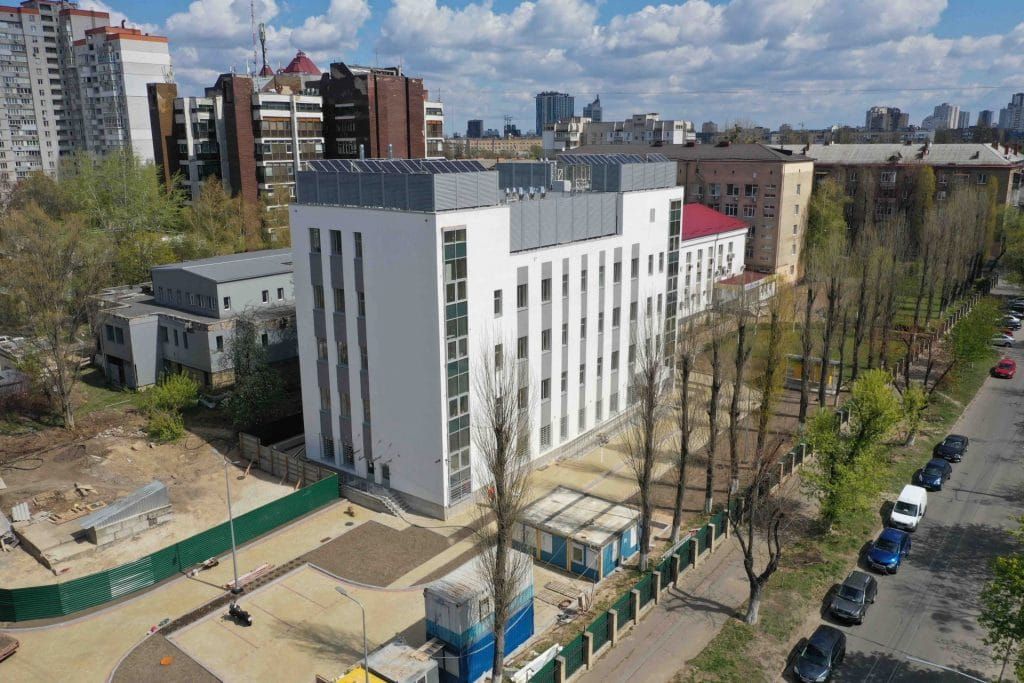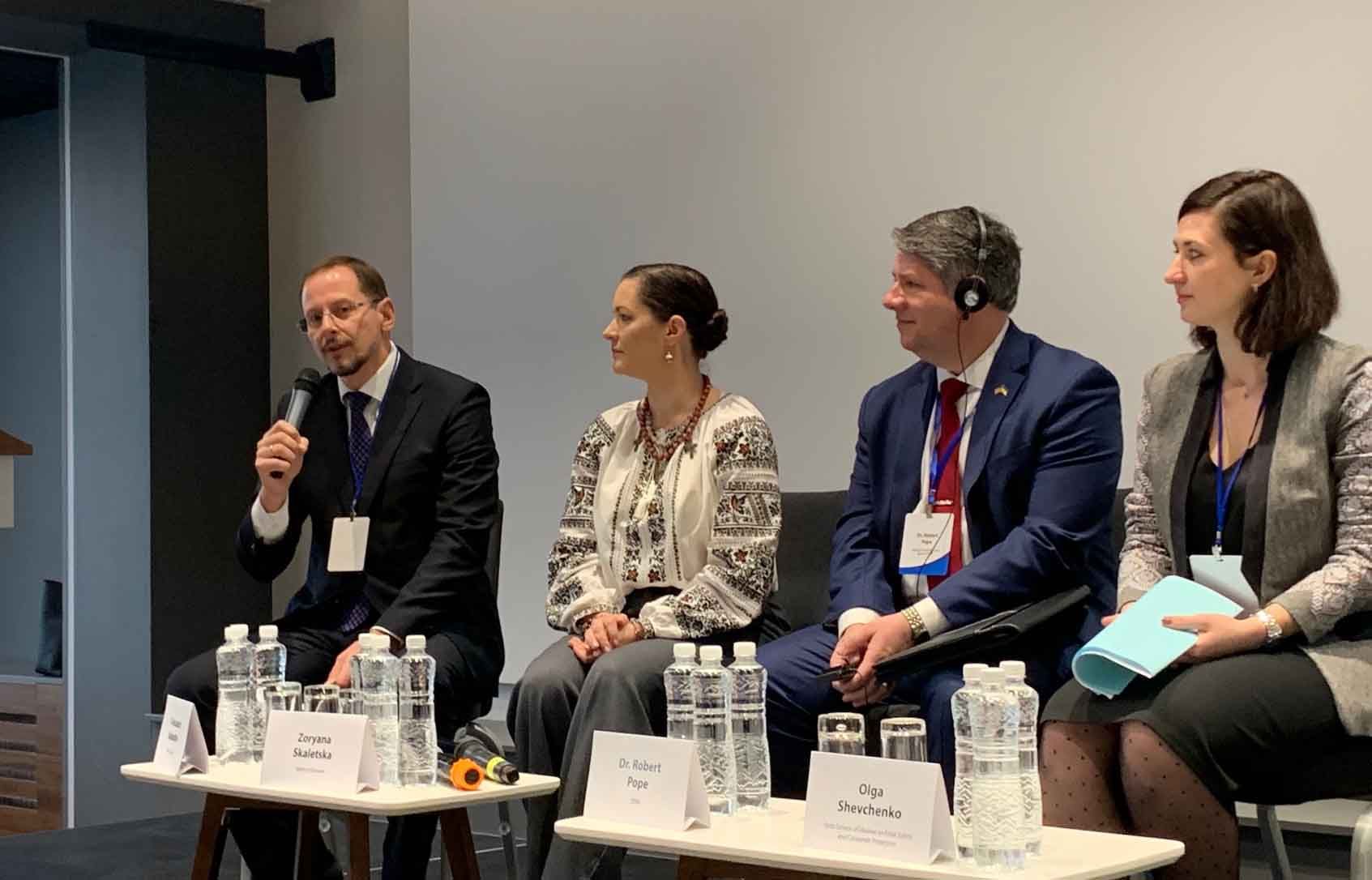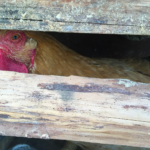US official: Russian invasion of Ukraine risks release of dangerous pathogens
By Matt Field | February 25, 2022
 A research lab in Kyiv, Ukraine built by the Cooperative Threat Reduction Program. Credit: Defense Threat Reduction Agency
A research lab in Kyiv, Ukraine built by the Cooperative Threat Reduction Program. Credit: Defense Threat Reduction Agency
The Russian invasion of Ukraine may put at risk a network of US-linked labs in Ukraine that work with dangerous pathogens, said Robert Pope, the director of the Cooperative Threat Reduction Program, a 30-year-old Defense Department program that has helped secure the former Soviet Union’s weapons of mass destruction and redirect former bioweapons facilities and scientists toward peaceful endeavors.
The labs in Ukraine are not bioweapons facilities. The US government maintains that they are public and animal health labs operated by host countries. Although a long-running Russian disinformation campaign has painted a picture of a network of US military labs in Ukraine, Georgia, and other former Soviet republics involved in bioweapons or risky research, Pope said the labs conduct peaceful scientific research and disease surveillance. Outside experts have also said Pope’s program is not a covert bioweapons operation.
While the United States isn’t maintaining bioweapons facilities, Pope said, war could put pathogen collections in Ukraine at risk.
“I would say from every facility that we have worked with them in, we have confidence that as long as the electrical power is turned on and the people we have trained are present at the facility, the biosafety officers, that these pathogens are safe and secure to international standards,” Pope said. “Should these facilities be damaged by conflict, that could change.”
The pathogens with which the Cooperative Threat Reduction Program labs work are generally kept frozen, so they can’t replicate and become infectious. The risk the pathogens pose would increase if a building lost power and suffered damage. “If you lose the electrical power, the pathogens in the freezers warm up,” he said. “If the ventilation system is damaged, or the building itself is damaged, and these now ambient-temperature pathogens are able to escape the facility, then they can be potentially infectious in the region around the facility.”
Although Russian officials and media have misrepresented the US-supported labs in Ukraine and other former Soviet countries in disinformation campaigns, Pope doesn’t believe the Russians will deliberately aim weapons at the labs during the invasion.
“I think the Russians know enough about the kinds of pathogens that are stored in biological research laboratories that I don’t think they would deliberately target a laboratory,” Pope said. “But what I do have concerns about is that they would … be accidentally damaged during this Russian invasion.”
The invasion could also provide fodder for new disinformation narratives around the labs, Pope feared. The Russians, he said, “could potentially go to one of these facilities and fabricate something that they call evidence of nefarious activity at the facility.”
The pathogens in Ukrainian labs vary by facility, Pope said, but some can be characterized as presenting a concern in the Ukrainian environment. As an example, he cited African swine fever virus, which is highly contagious in pigs and has caused hundreds of outbreaks in Ukraine since 2012. Some labs, he said, may hold pathogen strains left over from the Soviet bioweapons program, preserved in freezers for research purposes.
“There is no place that still has any of the sort of infrastructure for researching or producing biological weapons,” Pope said. “Scientists being scientists, it wouldn’t surprise me if some of these strain collections in some of these laboratories still have pathogen strains that go all the way back to the origins of that program.”
The program is encouraging host countries to reduce the scope of their pathogen holdings to as small of a collection as necessary for legitimate scientific research, Pope said.
“What we have today and what these countries maintain are small amounts of various pathogens that by and large are things that are collected out of their environment that they need for research to be able to legitimately surveil disease and develop vaccines against,” he said.
This work, Pope said, continued in Ukraine until recently. “They have more pathogens in more places than we recommend,” he said. The program had been helping Ukrainian researchers sift through their frozen pathogen collections, with the goal of persuading the Ukrainians to preserve their genetic information of samples via sequencing before destroying the live samples.
Pope said his program had been close to an agreement with the Ukrainians on consolidating samples, but the invasion has now made that project uncertain. “All of that, obviously, has been derailed here with the recent events,” he said.
The Cooperative Threat Reduction Program, Pope said Thursday, has not had contact with biosafety staff at the labs in Ukraine since the Russian invasion. Phone lines have been jammed in Ukraine, he said, and “I don’t know what kind of contact we will have in these labs in the near future.”
Some Ukrainian labs, like the Ukrainian Ministry of Health’s Public Health Center, Pope said, are major facilities, others small. Some are new, while others date back to the Soviet-era and the country’s bioweapons program.
The US government has worked with 26 facilities in Ukraine. Before the invasion, the program provided direct material support to six Ukrainian labs. The program also provides biosafety and scientific mentorship training to Ministry of Health personnel throughout the country.

Researchers consider the Soviet bioweapons program to be the most extensive and sophisticated to have existed, employing some 65,000 scientists. While both the United States and the Soviet Union signed the 1972 Biological Weapons Convention banning biological weapons, the Soviet Union went on to secretly expand its program. The country’s program had a forward-looking orientation; it sought, for instance, to develop chimeric viruses that had the genetic properties of two viruses and even to create viral/bacterial hybrids, biosecurity experts Milton Leitenberg and Raymond Zilinskas wrote a well-regarded history of the program in 2012.
The Cooperative Threat Reduction Program began with heavy Russian involvement. In the early 1990s, “employees at the multiple former biological weapon facilities operated by Biopreparat, the non-military part of the program, were increasingly desperate to support themselves and their families,” according to a 2020 account published by the US National Academies of Sciences, Engineering, and Medicine. An agreement among the European Union, the United States, Russia, and Japan led to the development of the International Science and Technology Center in Moscow, which channeled US Cooperative Threat Reduction Program resources and funds from other countries into scientific projects involving former biological weapons experts.
The technology center supported thousands of “former weaponeers,” who worked on projects in areas such as lab safety, infectious disease research, medical countermeasures, and diagnostic test development.
The Pentagon even sponsored Western scientists to work in former Russian bioweapons labs. By 2012, however, the arrangement between Russia, the United States, and others began to unravel, and Russia ended its agreement to host the International Science and Technology Center, which has since moved to Kazakhstan.
Cooperative Threat Reduction Program efforts have continued in the former Soviet republics of Ukraine and Georgia. After 9/11, the program began to focus more on how terrorists could misuse biological research and the program’s biological threat reduction component, as opposed to programs involving nuclear or chemical weapons, Pope said. Now, 62 percent of the program’s $360 million budget for this fiscal year is focused on biological issues.
At some point after Russia pulled out of the Cooperative Threat Reduction Program, disinformation campaigns involving Russian officials, state media, and others began to allege that the United States was running a bioweapons program on Russia’s periphery, or that it was jeopardizing the health of local citizens with dangerous experimentation. As Russia’s march to war in Ukraine heated up, so too did a campaign to discredit US-affiliated labs in the country.
Pope suspects the Russian disinformation campaign against the Cooperative Threat Reduction Program stems from Russian President Vladimir Putin’s vision of wielding influence in the countries surrounding Russia
“You look at the partners we have in several of the former Soviet republics, like Armenia, Azerbaijan, Georgia, Kazakhstan, Ukraine, and Uzbekistan, where we have had great partnerships over many years—I think Vladimir Putin looks at that as a zero-sum game of, ‘if they are partnering with the US, then that is a threat to the Russian sphere of influence,’” Pope said.
Putin’s end game in Ukraine remains unclear. On the second day of the invasion, Russian troops had reportedly advanced into the capital Kyiv. By any measure, Ukraine’s popular government is teetering on the edge. Pope said he’s anxious to resume working with his partners in Ukraine. That is not a sure prospect at this point.
Together, we make the world safer.
The Bulletin elevates expert voices above the noise. But as an independent nonprofit organization, our operations depend on the support of readers like you. Help us continue to deliver quality journalism that holds leaders accountable. Your support of our work at any level is important. In return, we promise our coverage will be understandable, influential, vigilant, solution-oriented, and fair-minded. Together we can make a difference.
Keywords: Cooperative Threat Reduction, Disinformation, Ukraine
Topics: Biosecurity
















We can restock labs later. Disposing of anything of threat at this point is the responsibility of the scientists running those labs or they are as liable.
Every laboratory facility ensures their potentially dangerous materials do not escape into the public or they face consequences. This should be no different. Incinerating on site should be feasible in light of active war in the country.
Okay well if they’re willingly not going to incinerate these pathogens…..wouldn’t Russia bombing these pathogen facilities be the next best thing? You would think a missile or a bomb would easily incinerate these pathogens…..
A missile or bomb would just as easily release pathogens as it would incinerate them. Intentional destruction should be the priority
I’m just sayin…..If Ukraine’s Lab staff didn’t already immediately incinerate ALL of the pathogens present in their labs as soon as Russia’s full scale invasion began…….then wouldn’t we actually want Russia to send a missile/bomb to these lab’s? To ensure the pathogens are destroyed? Since a missile/bomb would most likely incinerate EVERYTHING in it’s direct path. You know I think people forget that the COVID-19 pandemic is still in full swing! It was never declassified as no longer being a pandemic and now you’re telling me the world needs to worry more about these pathogens potentially being released during this… Read more »
Vanessa, explosives don’t work the way movies and video games portray them. If a building sustains a direct hit with a piece of ordinance large enough to collapse the entire building into a pile of rubble, that doesn’t even guarantee that every human inside will be dead, let alone even come close to killing bacteria and viruses inside the building. Bomb and missiles kill people by inflicting trauma to organs and tissue. They don’t “vaporize” people, that’s just not a thing. They typically kill by causing shrapnel to fly through bodies, whether the shrapnel is part of the ordinance or… Read more »
Thermobaric weapons. Hotter than Hot. They are in use for this purpose.
The purpose of the use, and the very reason for the existence of, thermobaric is to dramatically increase the “quality” and the severity of blast injuries. In other words, they kill more people. Mostly innocent civilians in nearly every case. That they would also kill any dangerous pathogens in the area of the blast is just an added unintentional “bonus”. You are claiming that thermobaric weapons are used for the purpose of destroying pathogens. You imply that both the purpose of the development and of the use of the weapons was and is a noble one. Which compels me to… Read more »